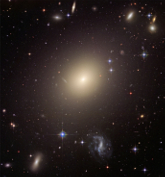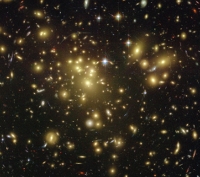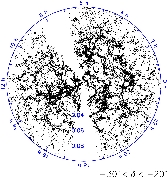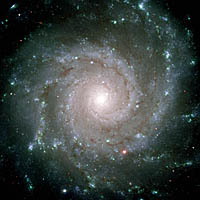Galaxies – the starry sky and Andromeda
The Andromeda
Galaxy is estimated to contain in the region of one trillion stars,
and is on a collision course with the Milky Way – we have a few billion years
to go yet!
Galaxies can be named by various methods – our own is named for it’s appearance
in a clear dark sky, where it looks like a milky river, or milk spilled across
the sky by ancient gods. Other galaxies like this include the whirlpool galaxy,
a fantastic spiral galaxy. They can be named by names and numbers, often
in conjunction with a full name. One main numerical system is the Messier
Catalogue, compiled by Charles Messier in the late 1700s. His goal was to
compile a list of things which weren’t comets, the resulting list of Messier
objects being catalogued as M1, M2 etc. The Andromeda Galaxy, as well as
having a Messier Number, can be found in the constellation of Andromeda as
can be seen in the starchart.
 Galaxies come in a few types, defined by shape, the main ones being spiral
and eleptical. The Milky Way and Andromeda are examples of spiral galaxies,
have a flattened, disk-like appearance with a central bulge, a bit like
two fried eggs stuck back to back. Eleptical galaxies tend to form after
the
merging of two or more spiral galaxies, and are fuzzy blobs of stars.
The colour of a galaxy can tell us if it is forming stars or not – galaxies
containing many star-forming regions tend to be blueish, while the reddish
ones contain few if any young stars. Spiral galaxies tend to contain more
blue, while elipticals are ‘dead’ and form very few new stars. When two
spirals collide, the resulting turbulence within the galaxies triggers a
massive
burst of star formation, after which new stars stop forming, and the eleptical
contains an aging population.
Galaxies come in a few types, defined by shape, the main ones being spiral
and eleptical. The Milky Way and Andromeda are examples of spiral galaxies,
have a flattened, disk-like appearance with a central bulge, a bit like
two fried eggs stuck back to back. Eleptical galaxies tend to form after
the
merging of two or more spiral galaxies, and are fuzzy blobs of stars.
The colour of a galaxy can tell us if it is forming stars or not – galaxies
containing many star-forming regions tend to be blueish, while the reddish
ones contain few if any young stars. Spiral galaxies tend to contain more
blue, while elipticals are ‘dead’ and form very few new stars. When two
spirals collide, the resulting turbulence within the galaxies triggers a
massive
burst of star formation, after which new stars stop forming, and the eleptical
contains an aging population.
On an even larger scale, galaxies can form clumps, or clusters, which can
contain a mixture of all different types of galaxies, like the one on the
right. These galaxy clusters can contain enough mass that their gravity
effects light, bending the path of light as it passes. This gravitational
lensing effect can sometimes be used as a giant magnifying glass, and some
of the most distant galaxies have been discovered due to this effect.
all different types of galaxies, like the one on the
right. These galaxy clusters can contain enough mass that their gravity
effects light, bending the path of light as it passes. This gravitational
lensing effect can sometimes be used as a giant magnifying glass, and some
of the most distant galaxies have been discovered due to this effect.
 Finally, at the extreme end of the scale, galaxies and clusters tend to form
into filaments rather than being evenly distributed across the universe.
This is known as large-scale structure.
Finally, at the extreme end of the scale, galaxies and clusters tend to form
into filaments rather than being evenly distributed across the universe.
This is known as large-scale structure.

